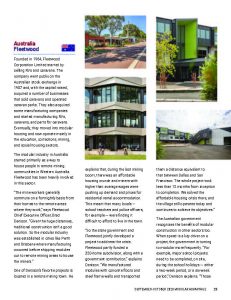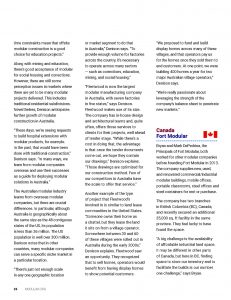The Modular Advantage – Fleetwood Australia
Founded in 1964, Fleetwood Corporation Limited started by selling RVs and caravans. The company went public on the Australian stock exchange in 1987 and, with the capital raised, acquired a number of businesses that sold caravans and operated caravan parks. They also acquired some manufacturing companies and started manufacturing RVs, caravans, and parts for caravans. Eventually, they moved into modular housing and now operate mainly in the education, corrections, mining, and social housing sectors. The modular industry in Australia started primarily as a way to house people in remote mining communities in Western Australia. Fleetwood has been heavily involved in this sector.
“The mine workers generally commute on a fortnightly basis from their homes to the remote areas where they work,” says former Fleetwood Chief Executive Officer, Brad Denison. “Given the huge distances, traditional construction isn’t a good solution. So, the modular industry was established in cities like Perth and Brisbane where manufacturing occurred before shipping modules out to remote mining areas to house the miners.”
One of Denison’s favourite projects is located in a remote mining town. He explains that, during the last mining boom, there was an affordable housing crunch and miners with higher than average wages were pushing up demand and prices for residential rental accommodation. This meant that many locals — school teachers and police officers, for example — were finding it difficult to afford to live in the town.
“So the state government and Fleetwood jointly developed a project to address the crisis. Fleetwood partly funded a 320-home subdivision, along with a government contribution,” explains Denison. “We manufactured modules with concrete floors and steel frame walls and transported them a distance equivalent to that between Dallas and San Francisco. The whole project took less than 12 months from inception to completion. We solved the affordable housing crisis there, and the village still operates today and continues to achieve its objectives.”
The Australian government recognizes the benefits of modular construction in other sectors too. When speed is a key driver on a project, the government is turning to modular more frequently. “For example, major school projects need to be completed, on site, during the school holidays — either a two-week period, or a six-week period,” Denison explains. “Those time constraints mean that offsite modular construction is a good choice for education projects.”
Along with mining and education, there’s good acceptance of modular for social housing and corrections. However, there are still some perception issues in markets where there are yet to be many modular projects delivered. This includes traditional residential subdivisions. Nevertheless, Denison anticipates further growth of modular construction in Australia.
“These days, we’re seeing requests to build hospital extensions with modular products, for example. In the past, that would have been done with traditional construction,” Denison says. “In many ways, we learn from modular companies overseas and use their successes as a guide for deploying modular solutions in Australia.”
The Australian modular industry learns from overseas modular companies, but there are crucial differences. In particular, although Australia is geographically about the same size as the 48 contiguous states of the US, its population is less than 26 million. The US population is well over 300 million. Denison notes that in other countries, many modular companies can serve a specific niche market in a particular location.
“There’s just not enough scale in any one geographic location or market segment to do that in Australia,” Denison says. “To provide enough volume for factories across the country, it’s necessary to operate across many sectors — such as corrections, education, mining, and social housing.”
“Fleetwood is now the largest modular manufacturing company in Australia, with seven factories in five states,” says Denison. Fleetwood makes use of its size. The company has in-house design and architectural teams and, quite often, offers those services to clients for their projects, well ahead of tender stage. “While there’s a cost in doing that, the advantage is that once the tender documents come out, we hope they contain our drawings,” Denison explains. “Those drawings are optimized for our construction method. Few of our competitors in Australia have the scale to offer that service.”
Another example of the type of project that Fleetwood’s involved in is similar to land lease communities in the United States. “Someone owns their home as a chattel, but they lease the land it sits on from a village operator. Somewhere between 30 and 60 of these villages were rolled out in Australia during the early 2000s,” Denison explains. Fleetwood saw an opportunity. They recognized that to sell homes, operators would benefit from having display homes to show potential customers.
“We proposed to fund and build display homes across many of these villages, and that operators pay us for the homes once they sold them to end customers. At one point, we were building 400 homes a year for two major Australian village operators,” Denison says. “We’re really passionate about leveraging the strength of the company’s balance sheet to penetrate new markets.”


